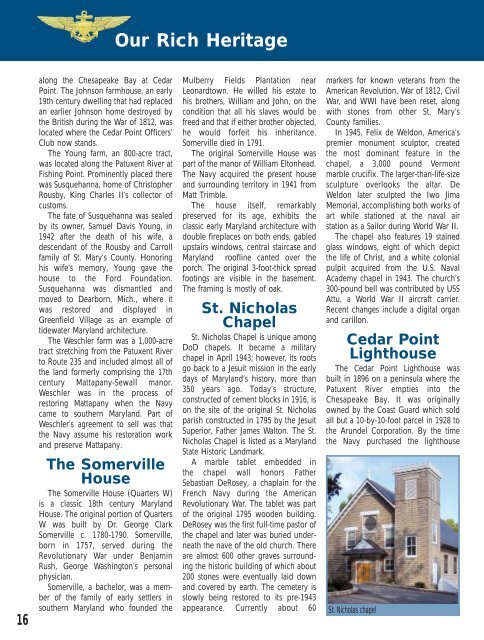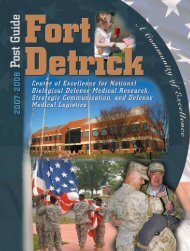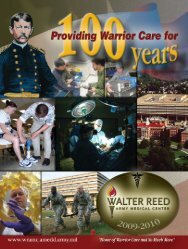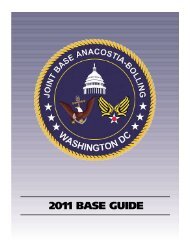About Naval Air Station Patuxent River - DCMilitary.com
About Naval Air Station Patuxent River - DCMilitary.com
About Naval Air Station Patuxent River - DCMilitary.com
You also want an ePaper? Increase the reach of your titles
YUMPU automatically turns print PDFs into web optimized ePapers that Google loves.
16<br />
along the Chesapeake Bay at Cedar<br />
Point. The Johnson farmhouse, an early<br />
19th century dwelling that had replaced<br />
an earlier Johnson home destroyed by<br />
the British during the War of 1812, was<br />
located where the Cedar Point Officers’<br />
Club now stands.<br />
The Young farm, an 800-acre tract,<br />
was located along the <strong>Patuxent</strong> <strong>River</strong> at<br />
Fishing Point. Prominently placed there<br />
was Susquehanna, home of Christopher<br />
Rousby, King Charles II’s collector of<br />
customs.<br />
The fate of Susquehanna was sealed<br />
by its owner, Samuel Davis Young, in<br />
1942 after the death of his wife, a<br />
descendant of the Rousby and Carroll<br />
family of St. Mary’s County. Honoring<br />
his wife’s memory, Young gave the<br />
house to the Ford Foundation.<br />
Susquehanna was dismantled and<br />
moved to Dearborn, Mich., where it<br />
was restored and displayed in<br />
Greenfield Village as an example of<br />
tidewater Maryland architecture.<br />
The Weschler farm was a 1,000-acre<br />
tract stretching from the <strong>Patuxent</strong> <strong>River</strong><br />
to Route 235 and included almost all of<br />
the land formerly <strong>com</strong>prising the 17th<br />
century Mattapany-Sewall manor.<br />
Weschler was in the process of<br />
restoring Mattapany when the Navy<br />
came to southern Maryland. Part of<br />
Weschler’s agreement to sell was that<br />
the Navy assume his restoration work<br />
and preserve Mattapany.<br />
The Somerville<br />
House<br />
The Somerville House (Quarters W)<br />
is a classic 18th century Maryland<br />
House. The original portion of Quarters<br />
W was built by Dr. George Clark<br />
Somerville c. 1780-1790. Somerville,<br />
born in 1757, served during the<br />
Revolutionary War under Benjamin<br />
Rush, George Washington’s personal<br />
physician.<br />
Somerville, a bachelor, was a member<br />
of the family of early settlers in<br />
southern Maryland who founded the<br />
Our Rich Heritage<br />
Mulberry Fields Plantation near<br />
Leonardtown. He willed his estate to<br />
his brothers, William and John, on the<br />
condition that all his slaves would be<br />
freed and that if either brother objected,<br />
he would forfeit his inheritance.<br />
Somerville died in 1791.<br />
The original Somerville House was<br />
part of the manor of William Eltonhead.<br />
The Navy acquired the present house<br />
and surrounding territory in 1941 from<br />
Matt Trimble.<br />
The house itself, remarkably<br />
preserved for its age, exhibits the<br />
classic early Maryland architecture with<br />
double fireplaces on both ends, gabled<br />
upstairs windows, central staircase and<br />
Maryland roofline canted over the<br />
porch. The original 3-foot-thick spread<br />
footings are visible in the basement.<br />
The framing is mostly of oak.<br />
St. Nicholas<br />
Chapel<br />
St. Nicholas Chapel is unique among<br />
DoD chapels. It became a military<br />
chapel in April 1943; however, its roots<br />
go back to a Jesuit mission in the early<br />
days of Maryland’s history, more than<br />
350 years ago. Today’s structure,<br />
constructed of cement blocks in 1916, is<br />
on the site of the original St. Nicholas<br />
parish constructed in 1795 by the Jesuit<br />
Superior, Father James Walton. The St.<br />
Nicholas Chapel is listed as a Maryland<br />
State Historic Landmark.<br />
A marble tablet embedded in<br />
the chapel wall honors Father<br />
Sebastian DeRosey, a chaplain for the<br />
French Navy during the American<br />
Revolutionary War. The tablet was part<br />
of the original 1795 wooden building.<br />
DeRosey was the first full-time pastor of<br />
the chapel and later was buried underneath<br />
the nave of the old church. There<br />
are almost 600 other graves surrounding<br />
the historic building of which about<br />
200 stones were eventually laid down<br />
and covered by earth. The cemetery is<br />
slowly being restored to its pre-1943<br />
appearance. Currently about 60<br />
markers for known veterans from the<br />
American Revolution, War of 1812, Civil<br />
War, and WWI have been reset, along<br />
with stones from other St. Mary’s<br />
County families.<br />
In 1945, Felix de Weldon, America’s<br />
premier monument sculptor, created<br />
the most dominant feature in the<br />
chapel, a 3,000 pound Vermont<br />
marble crucifix. The larger-than-life-size<br />
sculpture overlooks the altar. De<br />
Weldon later sculpted the Iwo Jima<br />
Memorial, ac<strong>com</strong>plishing both works of<br />
art while stationed at the naval air<br />
station as a Sailor during World War II.<br />
The chapel also features 19 stained<br />
glass windows, eight of which depict<br />
the life of Christ, and a white colonial<br />
pulpit acquired from the U.S. <strong>Naval</strong><br />
Academy chapel in 1943. The church’s<br />
300-pound bell was contributed by USS<br />
Attu, a World War II aircraft carrier.<br />
Recent changes include a digital organ<br />
and carillon.<br />
Cedar Point<br />
Lighthouse<br />
The Cedar Point Lighthouse was<br />
built in 1896 on a peninsula where the<br />
<strong>Patuxent</strong> <strong>River</strong> empties into the<br />
Chesapeake Bay. It was originally<br />
owned by the Coast Guard which sold<br />
all but a 10-by-10-foot parcel in 1928 to<br />
the Arundel Corporation. By the time<br />
the Navy purchased the lighthouse<br />
St. Nicholas chapel

















